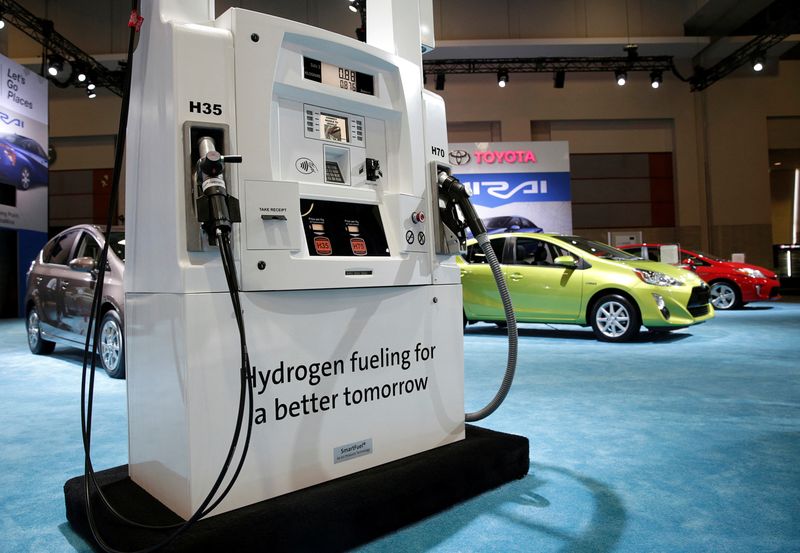US to release hydrogen subsidy guidance after COP28
2023.12.06 13:25

© Reuters. FILE PHOTO: A hydrogen dispensing pump is seen at the 2016 Toyota fuel cell Mirai display at the press day for the Washington Auto Show in Washington January 22, 2015. REUTERS/Gary Cameron/File Photo
By Valerie Volcovici
DUBAI (Reuters) – The U.S. will release guidance for how hydrogen producers can secure billions of dollars of subsidies embedded in last year’s Inflation Reduction Act sometime this year after the COP28 climate conference in Dubai, U.S. energy advisor John Podesta told Reuters on Wednesday.
Industry has been waiting anxiously for the guidance from the U.S. Treasury Department for months, as the administration debates whether to restrict the incentives to producers using new, instead of existing, clean energy sources to prevent an uptick in emissions.
Asked when the guidance would be released, Podesta said he expected it before the end of the year, but not during the Nov. 30 to Dec. 12 COP28 summit.
Hydrogen is a clean burning fuel that the Biden administration views as crucial to cleaning up hard-to-decarbonize industries like aluminum and cement. It is made by electrolyzing water and can be considered green if its production is powered by zero-emissions sources like solar, wind, nuclear or hydro.
While virtually no green hydrogen is produced now due to high costs and other constraints, the Biden administration is hoping to jumpstart the industry with subsidies of $3 per kilogram, embedded in the IRA.
At issue is a proposal, backed by environmental groups and some green hydrogen companies, that Treasury’s looming guidance should limit the new perks to hydrogen producers that power their facilities with new clean energy sources.
A study led by researchers from Princeton University found that without those limits the tax credits could have the unintended consequence of increasing emissions by raising overall power demand fed by fossil power.
Industry groups including nuclear backers, meanwhile, say an overly strict subsidy program would threaten the administration’s goals for green hydrogen by rendering some projects uneconomical.
U.S. Department of Energy Deputy Secretary David Turk said at an event on the sidelines of the COP28 summit that the tax credit is so lucrative and its impact is so big that even federal agencies are split over the design.
“It’s a big tax credit. We have to get it right,” Turk said.
He said Treasury and the Department of Energy still have differing opinions on the design.
One source who was briefed on a preliminary draft of the guidance said it included the so-called additionality provision redlining existing power sources, but that the administration is considering special treatment for nuclear and hydro.
The source, who asked not to be named, said the draft also required hydrogen electrolyzers to run at the same time as renewable energy to ensure the hydrogen is not produced using fossil fuel electricity.
In addition to the IRA subsidies, the DOE has selected seven proposed regional “hydrogen hubs” that will get $7 billion to try to demonstrate and scale up a clean hydrogen.
Three of the proposed hubs would include existing nuclear plants, and it is unclear if the hubs would be economically feasible if those reactors were cut out of the IRA subsidy.
Marty Durbin, president of the U.S. Chamber of Commerce’s Global Energy Institute, told Reuters that enabling production to start faster, with looser rules, would have long-term benefits.
“There might be a little uptake in greenhouse gas emissions in the power sector in the early stages but they’ll be far offset by the decarbonisation of these energy intensive sectors over the long term,” he said.
Claire Behar, chief commercial officer for HyStor energy, a green hydrogen company developing a hub in Mississippi, said her company prefers the tougher rules. “We have one shot to get this right for decarbonization,” she said.








